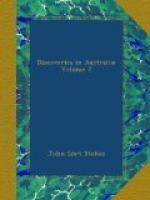Swan River Native.
Anchor under Rottnest.
Vocabulary.
Erect beacons.
Bad weather.
Habits of a native dog.
Geological observations.
Sail from Swan River.
Error in position of Cape Naturaliste.
King George’s Sound.
Appearance of Bald Head.
Princess Royal Harbour.
Origin of settlement.
Town of Albany.
Salubrity of climate.
Excursion into interior.
Course a kangaroo.
Pitfalls.
Herds of kangaroos.
Rich country.
The Hay River.
Return to Albany.
Departure for South Australia.
Discover an Island.
Death of a seaman.
Position of Neptune Isles.
Kangaroo, Althorp and Quoin Islands.
Holdfast Road.
Adelaide.
Description of country.
Governor Gawler’s policy.
Visit the Port.
Mr. Eyre’s expedition.
Hardships of Overlanders.
Cannibalism.
Meet Captain Sturt.
Native schools.
System of education.
Sail for Sydney.
Squalls.
Error in coast.
Bass Strait.
Arrive at Sydney.
Leaving Rottee we passed, soon after dark, round the western end of Pulo Douw, and stood for the position of a shoal reported by Mr. Lewis of the Colonial schooner, Isabella, to be in latitude 14 degrees 43 minutes South, and longitude 119 degrees 20 minutes East. Our inducement to search for this shoal was the fact of its being supposed to lie in the direct route of vessels sailing between Timor and the West coast of Australia. But after searching from the 9th to the 14th, and sounding repeatedly without getting bottom, we came to the conclusion that it did not exist. Breakers could have been seen at least ten miles from the Beagle’s masthead, as there was a considerable swell from the south-west.
LIGHT WINDS.
On the 15th we were in latitude 16 degrees 05 minutes South and longitude 118 degrees 16 minutes East. After one of those stagnant calms so frequently met with near the equator, we got a light westerly breeze on the morning of the 18th. Towards midnight it freshened, veering from South-West by South to West-South-West with some rather sharp rain squalls. It appears that the westerly winds had already set in, and that the calm we experienced on the 17th was an unoccupied space between the easterly and westerly winds. There are few parts of the globe where light winds prevail so much as on the North-west coast of New Holland, particularly between the latitudes of 13 and 17 degrees, and from one to two hundred miles from the land. They are, however, excepting in the months of January, February, and March, from the eastward, south-east in the morning and east in the afternoon. These winds prevented us from making the coast on the eastward of Depuch Island; and as we had failed in getting a supply of provisions at Timor, we were compelled to relinquish the plan of continuing the examination of that part of the coast between the Turtle Islands and Roebuck Bay.




